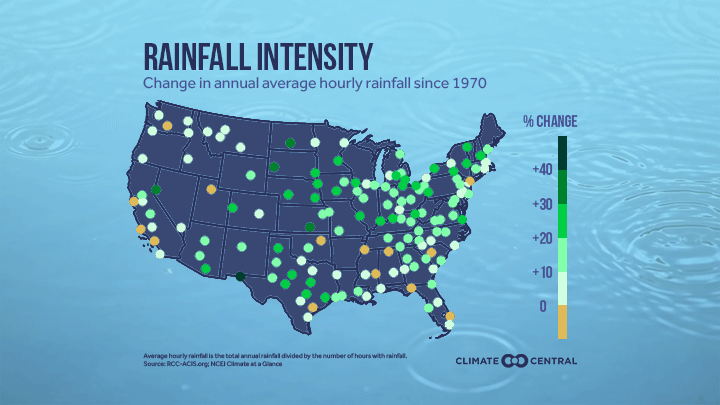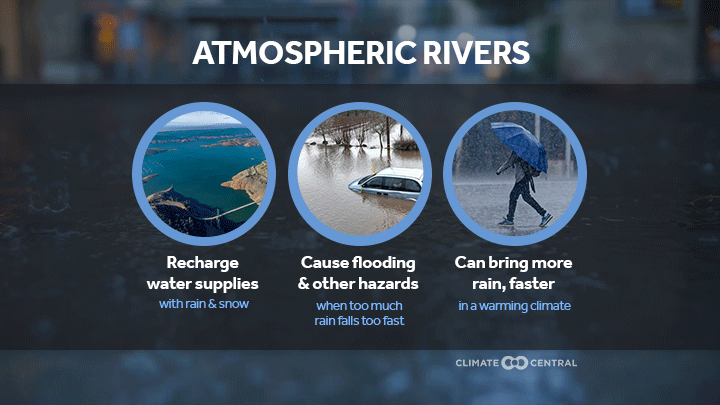Climate Matters•August 9, 2023
After the Storm: Damp, Moldy Homes
KEY CONCEPTS
Climate change increases risks of flooding from heavy rainfall, more intense storms, and rising sea levels.
Damp conditions in flooded buildings support the growth of mold and other microbes that can contribute to poor indoor air quality and a range of potential health issues.
Mold can begin growing in water-damaged buildings just days after a storm. But there are ways to manage mold risks in the aftermath and protect human health.
Climate Central’s new report, After the Storm: Health risks from damp, moldy homes, explains the weather and climate trends that influence flood risk, and summarizes potential health risks from poor indoor air quality.
A warming climate brings increasing flood risks and associated health impacts.
Heavier precipitation, more intense storms, and rising sea levels—all driven by a warming climate—contribute to increased risks of flooding and associated health impacts. Water-damaged homes provide ideal growing conditions for molds (types of fungi) and other microbes that can harm respiratory health and contribute to other illnesses.
Intensifying rainfall increases flood risks.
A warming atmosphere can hold more moisture, leading to heavier rainfall. Extreme rainfall events—which bring an amount of rain well above normal for the time and location, over a period of hours or even minutes—have been on the rise in the U.S. since the 1980s. These intense bursts of rainfall can elevate local risks of flooding.
Climate Central analyzed hourly rainfall intensity across the U.S. between 1970 and 2022. During this period, 136 of 150 U.S. locations analyzed have experienced increasing hourly rainfall intensity since 1970.
Climate Central’s Extreme Weather Toolkit: Heavy Rain and Flooding includes more resources on the links between climate change and extreme rainfall.

Atmospheric rivers contribute to extreme rainfall events.
Atmospheric rivers are ribbons of moisture carried by strong winds in the lower atmosphere. Climate change can boost conditions that make these events more likely or more intense. They vary in their strength and impacts, but strong atmospheric rivers can cause a range of serious hazards—including floods and the resulting health risks.

Warming oceans fuel stronger tropical cyclones
Hurricanes and tropical storms bring risks of heavy rains and flooding, especially to coastal communities.
Warming sea surface temperatures due to human-caused climate change fuel an increased proportion of intense tropical cyclones and contribute to an increased fraction of storms that undergo rapid intensification.
Since 1979, human-caused warming has increased the likelihood of a hurricane developing into a major hurricane (Category 3 or higher) by about 8% per decade. The latest IPCC reports conclude that the proportion of very intense (Category 4 and 5) tropical cyclones is projected to increase globally with continued global warming.
Climate Central’s Extreme Weather Toolkit: Tropical Cyclones includes more resources on the links between climate change and tropical cyclones—the most costly billion-dollar weather and climate disasters in the U.S.

Coastal cities face higher storm surge due to sea level rise.
Rising sea levels due to human-caused warming are worsening coastal floods during both regular high tides and coastal storms. Storm surge produced by coastal storms is affecting larger areas in many U.S. cities because of rising seas.
After the storm, mold growth can pose health risks.
Extreme weather events and floods can be dangerous—and the risks to health and safety don’t pass with the storm. One such risk is poor air quality in damp, moldy homes and buildings. In the days following a storm or flood, mold can begin growing on absorbent materials such as carpets, drywall, and furniture.
Climate Central’s report After the Storm: Health risks from damp, moldy homes summarizes research into the potential health risks from poor indoor air quality following extreme weather events.
Molds can be harmful to some people, depending on factors such as individual sensitivity and the amount or kinds of mold. Studies have identified acute and chronic health effects associated with dampness and indoor mold exposure, ranging from mild allergic reactions and respiratory infections to worsened asthma and severe illness.
Children and individuals with respiratory issues or weakened immune systems may be especially vulnerable to health issues from mold exposure after flooding.
Reducing risks from mold exposure
While more research is needed to better understand the potential impacts of mold, public health officials recommend minimizing exposure to moldy homes.
If you need to remain in a home with mold for a period of time, there are ways to minimize exposure, including:
Discarding wet, moldy items.
Sealing off moldy areas until they can be cleaned.
Maintaining indoor humidity between 30-50% to prevent more mold growth.
Using adequately sized portable high-efficiency particulate air (HEPA) filters in living spaces and (especially) bedrooms to improve air quality before mold remediation.
To protect against flooding and extreme precipitation, homeowners or renters can implement low-cost indoor projects recommended by FEMA. Communities can invest in flood management systems, green infrastructure, and watershed restoration.
Real stories of mold impacts
Climate Central's Partnership Journalism program collaborated with news outlets in New Jersey and Florida to investigate the impacts of mold on families following tropical storms.
"A look at how storms drive mold-related health issues, as Hurricane Ian’s anniversary approaches" (in collaboration with WUSF Public Media, greater Tampa Bay region)
“As floodwaters receded, poisonous mold flourished in NJ homes” (in collaboration with NJ Spotlight News, New Jersey)
LOCAL STORY ANGLES
How vulnerable is your area to flooding?
Flood vulnerability is influenced by factors including local topography, infrastructure age, and precipitation trends. Find current flood risks in your neighborhood with FloodFactor’s zipcode-level risk identifier. The American Society of Civil Engineers grades the integrity of infrastructures by state and category. You can also read Climate Central’s assessment of 23 U.S. cities vulnerable to coastal flooding during this decade, or use Climate Central’s Coastal Risk Screening Tool to map localized vulnerability to sea level rise and storm surges.
Where can you find information about safe storm cleanup?
The U.S. Environmental Protection Agency, Centers for Disease Control and Prevention, and Federal Emergency Management Agency offer detailed guidance for flood cleanup. Mold is just one of many potential hazards in a storm-damaged home. Other safety hazards include debris, structural damage, or downed electrical wires. Taking precautions following a storm, flood, or other natural disaster can protect health and safety.
Where can you learn more about the health risks from mold exposure?
The associations between mold exposure and some health impacts, such as allergies and respiratory problems, are clear. But more research is needed to better understand other potential health risks in both the short and long term. Organizations and agencies such as the CDC, World Health Organization, and Asthma and Allergy Foundation of America can all provide more information.
CONTACT EXPERTS
Mike Van Dyke, PhD
Associate Professor
Colorado School of Public Health, CU Anschutz Medical Campus
Relevant expertise: industrial hygienist, environmental health, risk communication
Contact: mike.vandyke@cuanschutz.edu
Gabriel Vecchi, PhD*
Professor of Geosciences
Director, High Meadows Environmental Institute
Princeton University
Relevant expertise: tropical meteorology and climate change
Contact: gvecchi@princeton.edu
*Available for interviews in Spanish and English
Felipe Quintero Duque, PhD*
Assistant Research Scientist
University of Iowa
Relevant expertise: rainfall and flood forecasting
Contact: felipe-quintero@uiowa.edu
*Available for interviews in Spanish and English
FIND EXPERTS
Submit a request to SciLine from the American Association for the Advancement of Science or to the Climate Data Concierge from Columbia University. These free services rapidly connect journalists to relevant scientific experts.
Browse maps of climate experts and services at regional NOAA, USDA, and Department of the Interior offices.
Explore databases such as 500 Women Scientists, BIPOC Climate and Energy Justice PhDs, and Diverse Sources to find and amplify diverse expert voices.
Reach out to your State Climate Office or the nearest Land-Grant University to connect with scientists, educators, and extension staff in your local area.
Browse Columbia University’s list of Climate Experts for experts on adaptation, mitigation, and resilience; extreme weather and natural disasters; and health, among other topics.
